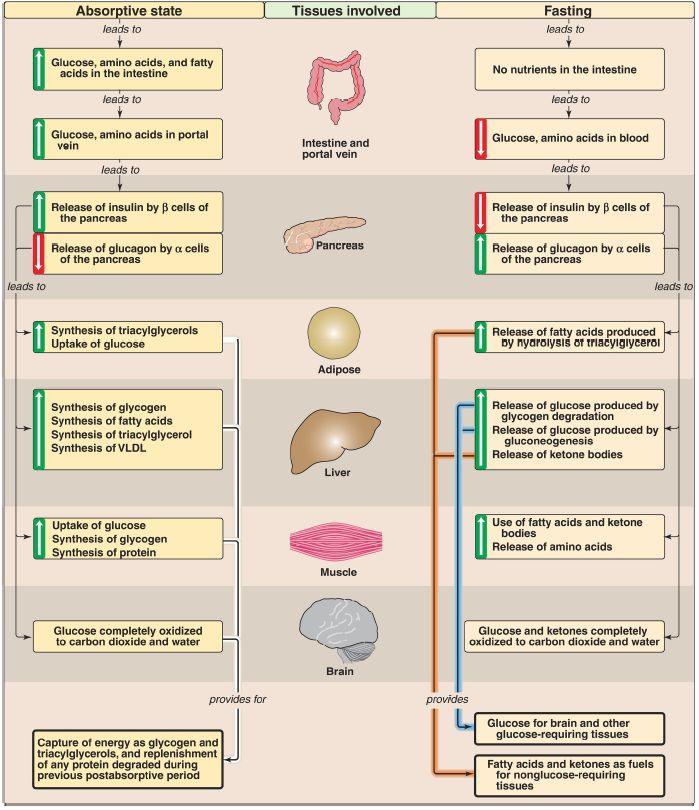


 النبات
النبات
 الحيوان
الحيوان
 الأحياء المجهرية
الأحياء المجهرية
 علم الأمراض
علم الأمراض
 التقانة الإحيائية
التقانة الإحيائية
 التقنية الحيوية المكروبية
التقنية الحيوية المكروبية
 التقنية الحياتية النانوية
التقنية الحياتية النانوية
 علم الأجنة
علم الأجنة
 الأحياء الجزيئي
الأحياء الجزيئي
 علم وظائف الأعضاء
علم وظائف الأعضاء
 الغدد
الغدد
 المضادات الحيوية
المضادات الحيوية|
Read More
Date: 16-9-2021
Date: 3-11-2021
Date: 9-9-2021
|
Feed–Fast Cycle
The flow of intermediates through metabolic pathways is controlled by four regulatory mechanisms: 1) the availability of substrates, 2) allosteric activation and inhibition of enzymes, 3) covalent modification of enzymes, and 4) induction-repression of enzyme synthesis. In the absorptive state, the 2- to 4-hour period after ingestion of a meal, these mechanisms insure that available nutrients are captured as glycogen, triacylglycerol (TAG), and protein (Fig. 1).
During this interval, transient increases in plasma glucose, amino acids, and TAG occur, the last primarily as components of chylomicrons synthesized by the intestinal mucosal cells. The pancreas responds to the elevated levels of glucose with an increased secretion of insulin and a decreased secretion of glucagon.
The elevated insulin/glucagon ratio and the ready availability of circulating substrates make the absorptive state an anabolic period during which virtually all tissues use glucose as a fuel. In addition, the liver replenishes its glycogen stores, replaces any needed hepatic proteins, and increases TAG synthesis.
The latter are packaged in very-low-density lipoproteins, which are exported to the peripheral tissues. Adipose tissue increases TAG synthesis and storage, whereas muscle increases protein synthesis to replace protein degraded since the previous meal. In the fed state, the brain uses glucose exclusively as a fuel. In fasting, plasma levels of glucose, amino acids, and TAG fall, triggering a decline in insulin secretion and an increase in glucagon and epinephrine secretion. The decreased insulin/counterregulatory hormone ratio and the decreased availability of circulating substrates make the fasting state a catabolic period. This sets into motion an exchange of substrates among the liver, adipose tissue, skeletal muscle, and brain that is guided by two priorities: 1) the need to maintain adequate plasma levels of glucose to sustain energy metabolism of the brain and other glucose-requiring tissues and 2) the need to mobilize fatty acids (FA) from adipose tissue and release ketone bodies from liver to supply energy to other tissues. To accomplish these goals, the liver degrades glycogen and initiates gluconeogenesis, using increased FA oxidation to supply the energy and reducing equivalents needed for gluconeogenesis and the acetyl coenzyme A building blocks for ketogenesis. The adipose tissue degrades stored TAG, thus providing FA and glycerol to the liver. The muscle can also use FA as fuel as well as ketone bodies supplied by the liver. The liver uses the glycerol for gluconeogenesis. Muscle protein is degraded to supply amino acids for the liver to use in gluconeogenesis but decreases as ketone bodies increase. The brain can use both glucose and ketone bodies as fuels. From late fasting into starvation, the kidneys play important roles by synthesizing glucose and excreting the protons from ketone body dissociation as ammonium (NH4+).

Figure 1: Key concept map for the feed–fast cycle. VLDL = very-lowdensity lipoprotein.



|
|
|
|
تفوقت في الاختبار على الجميع.. فاكهة "خارقة" في عالم التغذية
|
|
|
|
|
|
|
أمين عام أوبك: النفط الخام والغاز الطبيعي "هبة من الله"
|
|
|
|
|
|
|
قسم شؤون المعارف ينظم دورة عن آليات عمل الفهارس الفنية للموسوعات والكتب لملاكاته
|
|
|